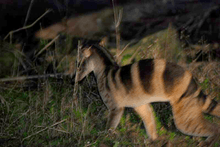Hemigalinae
| Hemigalinae | |
|---|---|
 | |
| Banded palm civet (Hemigalus derbyanus) | |
| Scientific classification | |
| Kingdom: | Animalia |
| Phylum: | Chordata |
| Class: | Mammalia |
| Order: | Carnivora |
| Suborder: | Feliformia |
| Family: | Viverridae |
| Subfamily: | Hemigalinae Gray, 1864 |
| Genera | |
The Hemigalinae are a subfamily of the viverrids denominated and first described by John Edward Gray in 1864.[1] This subfamily comprises the four monospecific genera:[2]
Characteristics
The tails of Hemigalinae species are ringed. The toes and the middle of the lower part of the tarsus are bald. The frenum, upper part, and sides of the lower part are hairy. The orbit is imperfect.[1]
Hemigalinae resemble the Viverrinae in having the scent glands present in both sexes and wholly perineal, but differing by their simpler structure, consisting in the male of a shallower, smaller pouch, with less tumid lips, situated midway between the scrotum and the penis, but not extending to either. In the female, the scent glands consist of a pair of swellings, each with a slit-like orifice, situated one on each side of the vulva and a little behind it and on a common eminence, the perineal area behind this eminence being naked. The prepuce is long and pendulous. The feet are nearly intermediate in structure between those of the digitigrade Viverrinae and the semiplantigrade Paradoxurinae, but more like the latter, both the carpal and metatarsal pads being well developed, double, and joining the plantar pad below, and as wide as it is at the point of contact. But the feet, with the pads, are considerably narrower, the carpals and metatarsals converging and meeting above so that a much larger area of the under surface is hairy. The area between the four main digits and the plantar pad is covered with short hair, and the pads of the third and fourth digits of the hind foot are separated as in the Viverrinae, not confluent as in the Paradoxurinae. The retractile claws are not protected by skin-lobes.[3]
References
- 1 2 Gray, J. E. (1864). A revision of the genera and species of viverrine animals (Viverridae), founded on the collection in the British Museum. Proceedings of the Zoological Society of London for the year 1864: 502–579.
- ↑ Wozencraft, W.C. (2005). "Order Carnivora". In Wilson, D.E.; Reeder, D.M. Mammal Species of the World: A Taxonomic and Geographic Reference (3rd ed.). Johns Hopkins University Press. p. 552–553. ISBN 978-0-8018-8221-0. OCLC 62265494.
- ↑ Pocock, R. I. (1939). The fauna of British India, including Ceylon and Burma. Mammalia. – Volume 1. Taylor and Francis, London. Pages 450–457.
| Wikimedia Commons has media related to Hemigalinae. |
| Wikispecies has information related to: Hemigalinae |